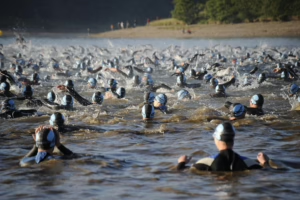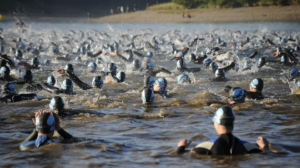Choosing Your Challenge: Which Triathlon Distance is Right for You?
The siren call of the triathlon is alluring. The challenge of swimming, biking, and running, strung together in a grueling test of endurance, draws athletes from all walks of life. But before you dive headfirst into the world of triathlons, a crucial decision awaits: which distance is right for you?
The triathlon spectrum spans a vast range, from the beginner-friendly sprint to the intimidating Ironman, each demanding a different level of fitness, training commitment, and mental fortitude. This article will serve as your comprehensive guide, dissecting the various triathlon distances, examining the factors that influence your choice, and providing practical advice to help you select the perfect challenge that aligns with your goals, experience, and lifestyle.
I. Understanding the Triathlon Landscape: A Spectrum of Distances
The triathlon world is populated by several standard distances, each offering a unique set of challenges and rewards. Understanding these distances is the first step towards finding the right fit.
-
Sprint Triathlon: Often considered the entry point into the sport, the sprint triathlon is the shortest of the standard distances. Typically consisting of a 750m swim, a 20km bike ride, and a 5km run, it’s a manageable undertaking for beginners with a reasonable level of fitness. [modern_footnote_source] Some sprint triathlons may even offer shorter “super sprint” options to further ease newcomers into the sport. The sprint distance is ideal for individuals who are new to endurance sports, short on time, or simply want to experience the thrill of a triathlon without committing to an extensive training regime.
-
Olympic Triathlon (Standard Distance): The Olympic distance, as the name suggests, is the distance contested at the Olympic Games. It comprises a 1.5km swim, a 40km bike ride, and a 10km run. This distance represents a significant step up from the sprint, demanding a higher level of endurance and more dedicated training. [modern_footnote_source] The Olympic triathlon is a good option for those who have completed a sprint triathlon and are looking for a more substantial challenge or for individuals with a strong running or cycling background who want to test their abilities across all three disciplines.
-
Half Ironman (70.3 or Middle Distance): Stepping into the realm of longer-distance triathlons, the Half Ironman presents a formidable challenge. Featuring a 1.9km swim, a 90km bike ride, and a 21.1km (half marathon) run, it requires a significant commitment to training and a solid base of endurance. [modern_footnote_source] The 70.3 distance, derived from the total mileage covered, is a popular choice for athletes seeking a demanding but attainable goal. It’s often seen as a stepping stone to the full Ironman or a challenging goal in its own right.
-
Ironman (140.6 or Full Distance): The pinnacle of triathlon achievement, the Ironman is a test of physical and mental limits. Consisting of a 3.8km swim, a 180km bike ride, and a 42.2km (marathon) run, it demands unwavering dedication, meticulous training, and a deep well of mental fortitude. [modern_footnote_source] Completing an Ironman is a life-changing experience, pushing athletes to their absolute limits and rewarding them with a sense of accomplishment that few other challenges can match.
-
Other Distances and Variations: Beyond these standard distances, numerous variations exist to cater to different preferences and skill levels. These include:
- Super Sprint Triathlon: A shorter version of the sprint distance, often featuring a 400m swim, a 10km bike ride, and a 2.5km run.
- Duathlon: Consisting of a run-bike-run format, duathlons are a good option for individuals who are not strong swimmers or who prefer to avoid open water swimming.
- Aquathlon: Combining swimming and running, aquathlons are ideal for those who enjoy both disciplines but may not be interested in cycling.
- Off-Road Triathlons (XTERRA): These triathlons take place on trails and unpaved surfaces, offering a different kind of challenge with mountain biking and trail running. [modern_footnote_source]
- Long Course Triathlon: Encompassing distances between the Olympic and Half Ironman distances, offering an intermediate challenge.
II. Factors to Consider: A Personalized Approach to Choosing Your Distance
Selecting the right triathlon distance is a highly personal decision, influenced by a multitude of factors. Carefully evaluating these factors will help you make an informed choice that aligns with your individual circumstances and goals.
-
Current Fitness Level: Your current fitness level is a crucial determinant in choosing the appropriate triathlon distance. If you are new to endurance sports, starting with a sprint triathlon is highly recommended. It allows you to gradually build your fitness base and acclimatize to the demands of swimming, biking, and running in succession. Attempting a longer distance without adequate preparation can lead to injury, burnout, or a negative experience that discourages you from pursuing future triathlons. If you already have a solid background in running, cycling, or swimming, you may be able to start with an Olympic distance or even a Half Ironman, but it’s still essential to gradually increase your training volume and intensity.
-
Training Time Commitment: Triathlon training requires a significant time commitment, especially for longer distances. The Ironman, for instance, can necessitate 10-20 hours of training per week, depending on your goals and experience. Carefully assess your available time and consider the impact that training will have on your work, family, and social life. Be realistic about your ability to consistently dedicate the necessary time to training, and choose a distance that fits comfortably within your schedule. A sprint triathlon typically requires 4-6 hours of training per week, while an Olympic distance may require 6-10 hours.
-
Prior Experience in Endurance Sports: Your prior experience in endurance sports, such as running, cycling, or swimming, can significantly influence your ability to tackle a triathlon. If you have a strong background in one or more of these disciplines, you may be able to progress more quickly to longer distances. For example, a marathon runner may find the run portion of an Ironman relatively less daunting than someone who is new to running. However, it’s important to remember that triathlon requires combining these disciplines, and even experienced athletes need to adapt their training to the specific demands of the sport.
-
Swimming Ability and Comfort in Open Water: Swimming is often the most challenging discipline for new triathletes, particularly open water swimming. If you are not a confident swimmer or are uncomfortable in open water, starting with a sprint triathlon or a pool-based triathlon is highly recommended. This will allow you to gradually improve your swimming skills and build your confidence in the water. Consider joining a swim club or taking swimming lessons to improve your technique and comfort level. Open water swimming requires specific skills, such as sighting, drafting, and dealing with waves and currents. Practicing in open water under the supervision of an experienced coach is crucial for developing these skills.
-
Injury History and Physical Limitations: Your injury history and any physical limitations should be carefully considered when choosing a triathlon distance. If you have a history of injuries, particularly in the legs, knees, or back, it’s essential to consult with a doctor or physical therapist before starting triathlon training. They can help you identify potential risks and develop a training plan that minimizes the risk of re-injury. Certain physical limitations, such as arthritis or joint problems, may make longer distances more challenging or even contraindicated. Choose a distance that is within your physical capabilities and listen to your body during training, taking rest days when needed.
-
Personal Goals and Motivations: Your personal goals and motivations play a crucial role in determining the right triathlon distance for you. Are you looking for a challenging but achievable goal to improve your fitness and health? Or are you seeking to push your limits and test your mental and physical endurance? Do you want to compete and improve your performance, or are you primarily focused on completing the race and enjoying the experience? Understanding your goals will help you choose a distance that aligns with your aspirations and provides the motivation you need to stay committed to training.
-
Budget and Equipment Costs: Triathlon can be an expensive sport, particularly for longer distances. The cost of equipment, such as a wetsuit, bike, running shoes, and triathlon apparel, can add up quickly. Entry fees for triathlons can also vary significantly depending on the distance and location. Consider your budget and factor in the cost of equipment, entry fees, travel expenses, and coaching if you plan to hire a coach. While it’s possible to participate in a sprint triathlon with minimal equipment, longer distances typically require more specialized gear.
-
Race Location and Course Profile: The location and course profile of a triathlon can significantly impact its difficulty. A hilly or mountainous course will be more challenging than a flat course, and a race in hot and humid conditions will be more demanding than a race in cooler weather. Consider the location and course profile when choosing a triathlon, and factor in the potential challenges when planning your training. Research the course beforehand and familiarize yourself with the elevation changes, road surfaces, and potential hazards.
III. Training Strategies for Different Triathlon Distances
Once you’ve chosen your triathlon distance, developing a comprehensive training plan is essential for success. The training plan should be tailored to your individual fitness level, goals, and the specific demands of the chosen distance.
-
General Principles of Triathlon Training: Regardless of the distance, all triathlon training plans should incorporate the following general principles:
- Progressive Overload: Gradually increasing the volume and intensity of your training over time to stimulate adaptation and improvement. [modern_footnote_source]
- Specificity: Focusing your training on the specific demands of swimming, biking, and running, and practicing the transitions between disciplines.
- Recovery: Allowing adequate rest and recovery to prevent overtraining and injury.
- Nutrition and Hydration: Fueling your body with a balanced diet and staying adequately hydrated to support your training and performance.
- Consistency: Consistently adhering to your training plan to maximize your progress.
-
Training for a Sprint Triathlon: Training for a sprint triathlon can be relatively straightforward, focusing on building a base of fitness in each discipline and practicing the transitions. A typical sprint triathlon training plan might include:
- Swimming: 2-3 swims per week, focusing on technique, speed, and endurance.
- Biking: 2-3 bike rides per week, incorporating both short, intense intervals and longer, endurance-building rides.
- Running: 2-3 runs per week, including interval training, tempo runs, and long runs.
- Brick Workouts: Combining a bike ride followed immediately by a run to simulate the race conditions and practice transitions.
-
Training for an Olympic Triathlon: Training for an Olympic triathlon requires a more structured and demanding approach, with a greater emphasis on endurance and speed. A typical Olympic triathlon training plan might include:
- Swimming: 3-4 swims per week, focusing on technique, speed, and open water swimming skills.
- Biking: 3-4 bike rides per week, incorporating longer rides, hill repeats, and interval training.
- Running: 3-4 runs per week, including interval training, tempo runs, and longer runs.
- Strength Training: Incorporating strength training exercises to improve power and prevent injury.
- Nutrition and Hydration: Developing a race-day nutrition and hydration strategy.
-
Training for a Half Ironman (70.3): Training for a Half Ironman requires a significant commitment to endurance training and meticulous planning. A typical Half Ironman training plan might include:
- Swimming: 3-4 swims per week, focusing on technique, open water swimming skills, and building endurance.
- Biking: 3-4 bike rides per week, incorporating long rides, hill repeats, and interval training.
- Running: 3-4 runs per week, including tempo runs, long runs, and brick workouts.
- Strength Training: Incorporating strength training exercises to improve power, prevent injury, and maintain muscle mass.
- Nutrition and Hydration: Practicing your race-day nutrition and hydration strategy during training.
- Mental Training: Developing mental strategies to cope with the challenges of a long-distance race.
-
Training for an Ironman (140.6): Training for an Ironman is the most demanding of all triathlon training regimes, requiring a significant time commitment, meticulous planning, and unwavering dedication. A typical Ironman training plan might include:
- Swimming: 4-5 swims per week, focusing on technique, open water swimming skills, and building extreme endurance.
- Biking: 4-5 bike rides per week, incorporating long rides, hill repeats, and interval training.
- Running: 4-5 runs per week, including tempo runs, long runs, and brick workouts.
- Strength Training: Incorporating strength training exercises to improve power, prevent injury, and maintain muscle mass.
- Nutrition and Hydration: Developing and practicing a comprehensive race-day nutrition and hydration strategy.
- Mental Training: Developing mental strategies to cope with the extreme challenges of an Ironman race.
- Rest and Recovery: Prioritizing rest and recovery to prevent overtraining and injury.
IV. Common Mistakes to Avoid: Navigating the Triathlon Learning Curve
Many new triathletes make common mistakes that can hinder their progress and increase their risk of injury. Being aware of these mistakes and taking steps to avoid them can significantly improve your training and race performance.
-
Doing Too Much, Too Soon: This is perhaps the most common mistake made by new triathletes. Eager to improve quickly, they often increase their training volume and intensity too rapidly, leading to overtraining, injury, and burnout. It’s essential to gradually increase your training load, allowing your body time to adapt and recover.
-
Ignoring Proper Technique: Focusing solely on speed and endurance without paying attention to proper technique can lead to inefficient movement patterns and increased risk of injury. Investing in coaching or attending technique clinics can help you develop efficient and effective swimming, biking, and running techniques.
-
Neglecting Strength Training: Many triathletes neglect strength training, believing that it’s not essential for endurance sports. However, strength training can improve power, prevent injury, and maintain muscle mass, all of which are crucial for triathlon performance. Incorporate strength training exercises into your training plan, focusing on compound exercises that work multiple muscle groups.
-
Poor Nutrition and Hydration: Proper nutrition and hydration are essential for fueling your training and recovery. Neglecting your diet can lead to fatigue, muscle cramps, and decreased performance. Develop a balanced diet that provides adequate carbohydrates, protein, and healthy fats. Practice your race-day nutrition and hydration strategy during training to avoid surprises on race day.
-
Inadequate Rest and Recovery: Rest and recovery are just as important as training. Overtraining can lead to fatigue, injury, and decreased performance. Allow adequate rest between training sessions and prioritize sleep. Incorporate rest days into your training plan and listen to your body, taking extra rest when needed.
-
Ignoring Open Water Swimming: If you are planning to participate in a triathlon with an open water swim, it’s essential to practice swimming in open water. Open water swimming presents unique challenges, such as sighting, drafting, and dealing with waves and currents. Practice in open water under the supervision of an experienced coach to develop these skills.
-
Neglecting Transitions: Transitions between swimming, biking, and running are an integral part of triathlon. Neglecting transitions can cost you valuable time and energy. Practice transitions during training to become efficient and smooth.
-
Not Seeking Professional Guidance: Hiring a qualified triathlon coach can provide you with personalized guidance, develop a training plan tailored to your individual needs, and help you avoid common mistakes. A coach can also provide motivation and support, helping you stay on track and achieve your goals.
V. The Mental Game: Cultivating Resilience and Perseverance
Triathlon is not just a physical challenge; it’s also a mental one. Cultivating resilience, perseverance, and a positive mindset is essential for success, particularly in longer distances.
-
Setting Realistic Goals: Setting realistic and achievable goals is crucial for maintaining motivation and preventing discouragement. Break down your overall goal into smaller, more manageable steps, and celebrate your progress along the way.
-
Developing a Positive Mindset: A positive mindset can help you overcome challenges and persevere through difficult times. Focus on your strengths, celebrate your successes, and learn from your setbacks.
-
Visualization: Visualizing yourself successfully completing the race can help you build confidence and reduce anxiety. Practice visualizing the swim, bike, and run portions of the race, as well as the transitions.
-
Mental Toughness Techniques: Develop mental toughness techniques, such as positive self-talk, mindfulness, and deep breathing, to cope with the challenges of training and racing.
-
Finding Your “Why”: Connecting with your personal reasons for participating in triathlon can provide you with the motivation and resilience you need to overcome obstacles and achieve your goals. Reflect on your “why” and remind yourself of it whenever you face challenges.
-
Building a Support System: Surrounding yourself with supportive friends, family, and training partners can provide you with encouragement and motivation. Share your goals with your support system and ask for their help when you need it.
VI. Conclusion: Embrace the Challenge and Enjoy the Journey
Choosing the right triathlon distance is a personal journey that requires careful consideration of your fitness level, training time commitment, experience, goals, and budget. By evaluating these factors and developing a comprehensive training plan, you can embark on a challenging and rewarding adventure that will test your limits and transform your life.
Whether you choose the sprint, Olympic, Half Ironman, or Ironman distance, remember to embrace the challenge, enjoy the journey, and celebrate your accomplishments along the way. The triathlon is more than just a race; it’s a testament to the power of human potential and the transformative power of dedication and perseverance. So, choose your challenge, commit to your training, and prepare to experience the thrill of crossing that finish line, knowing that you have pushed yourself to your absolute limits and achieved something truly extraordinary. The world of triathlon awaits – are you ready to answer its call?


























Add Comment